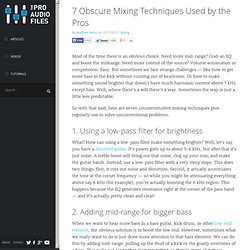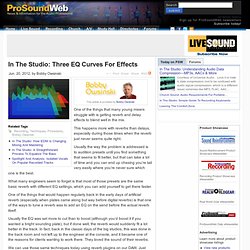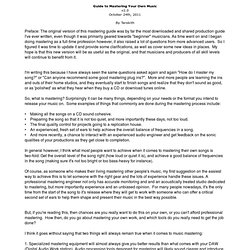

Mixing Secrets For The Small Studio: Additional Resources (Cambridge Music Technology) 7 Obscure Mixing Techniques Used by the Pros. Most of the time there is an obvious choice.

Need more mid-range? Grab an EQ and boost the midrange. Need more control of the source? Volume automation or compression. Easy. So with that said, here are seven counterintuitive mixing techniques pros regularly use to solve unconventional problems: 1. What? 2. When we want to hear more bass in a bass guitar, kick drum, or other low-end element, the obvious solution is to boost the low end. 3. But wait, doesn’t a compressor restrict dynamic range?
4. If you’re using a brickwall limiter on your master buss, chances are you’re doing so to make something loud. Well, yes and no. 5. Now that really doesn’t make sense. 6. Remember that reverb is used to create a sense of space. 7. Not that I feel loudness is absolutely paramount to a successful mix, but in today’s climate of iPods, noise-ridden listening environments, and DJ controlled playlists, it’s important that the record lives within the same general vicinity of apparent loudness. Handy EQ Reference. Understanding Sends, Auxes And Buses « Audio Geek Zine. Let’s talk about using sends to control effects, parallel processing and some of the other benefits of sends.

First we need to understand a few concepts. Buses, auxes and sends. What is a Bus? A bus is an audio pathway that allows you to move a sound from one part of the mixer to another. The main outputs of your mixer is a bus, often called the Master Bus. What is an Aux? An aux is essentially the output of the bus. What is a Send? A send splits the audio signal and ‘sends’ it somewhere else, usually through a bus, but can also be to a interface output.
The entrance to a bus is by assigning the output of the track in a virtual mixer or by using sends. Simple Signal Flow Lets take a typical signal path in a mix. A vocal track has it’s output set to your master bus. You could put the reverb plugin as an insert right on that vocal track, but it’s really not the most efficient way of working. Advanced Signal Flow. 3D Mixing. In The Studio: Three EQ Curves For Effects. One of the things that many young mixers struggle with is getting reverb and delay effects to blend well in the mix.

This happens more with reverbs than delays, especially during those times when the reverb just never seems quite right. Usually the way the problem is addressed is to audition presets until you find something that seems to fit better, but that can take a lot of time and you can end up chasing you’re tail very easily where you’re never sure which one is the best. What many engineers seem to forget is that most of those presets are the same basic reverb with different EQ settings, which you can add yourself to get there faster. One of the things that would happen regularly back in the early days of artificial reverb (especially when plates came along but way before digital reverbs) is that one of the ways to tune a reverb was to add an EQ on the send before the actual reverb itself. We can use those same techniques today using reverb plugins on our DAW. (click to enlarge) Free Multitracks For Mixing Practice! Resources > Freq Chart. Mastering.
Guide to Mastering Your Own Music v2.0 October 24th, 2011 By Tarekith Preface: The original version of this mastering guide was by far the most downloaded and shared production guide I've ever written, even though it was primarily geared towards "beginner" musicians.

As time went on and I began doing mastering as a full-time profession however, it also raised a lot of questions from more advanced users. So I figured it was time to update it and provide some clarifications, as well as cover some new ideas in places. My hope is that this new version will be as useful as the original, and that musicians and producers of all skill levels will continue to benefit from it. I'm writing this because I have always seen the same questions asked again and again "How do I master my song? " So, what is mastering?
But, if you're reading this, then chances are you really want to do this on your own, or you can't afford professional mastering. Mixing On Headphones. Technique : Recording / Mixing It's often necessary to work on headphones in the home studio, even when mixing.

So what headphones should you choose, and how do you go about getting the best results? Hugh Robjohns At one time or another, we all resort to using headphones while trying to assess a mix. There are numerous occasions when such a tactic is required: we might be working late at night where monitoring on loudspeakers is too antisocial; or perhaps we are recording on the move with portable equipment, so using loudspeakers becomes impractical. The Pros & Cons Of Mixing On Headphones The first thing to say is that, generally, headphone monitoring is almost always only a 'second best' option. The way in which our ears interpret sounds from loudspeakers is inherently very different to that from simple headphones. 50 Mixing Tips From Steven Slate.